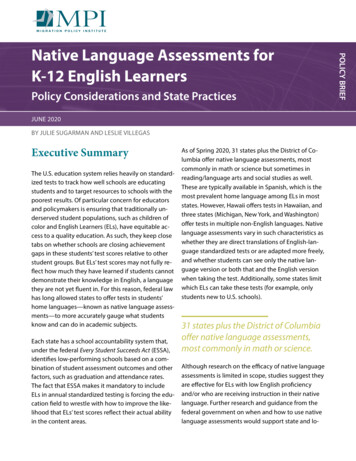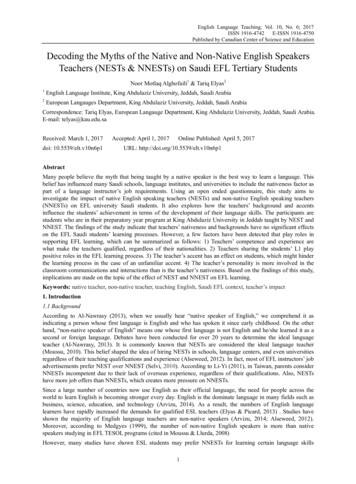
Transcription
Policy Considerations and State PracticesJUNE 2020BY JULIE SUGARMAN AND LESLIE VILLEGASExecutive SummaryThe U.S. education system relies heavily on standardized tests to track how well schools are educatingstudents and to target resources to schools with thepoorest results. Of particular concern for educatorsand policymakers is ensuring that traditionally underserved student populations, such as children ofcolor and English Learners (ELs), have equitable access to a quality education. As such, they keep closetabs on whether schools are closing achievementgaps in these students’ test scores relative to otherstudent groups. But ELs’ test scores may not fully reflect how much they have learned if students cannotdemonstrate their knowledge in English, a languagethey are not yet fluent in. For this reason, federal lawhas long allowed states to offer tests in students’home languages—known as native language assessments—to more accurately gauge what studentsknow and can do in academic subjects.Each state has a school accountability system that,under the federal Every Student Succeeds Act (ESSA),identifies low-performing schools based on a combination of student assessment outcomes and otherfactors, such as graduation and attendance rates.The fact that ESSA makes it mandatory to includeELs in annual standardized testing is forcing the education field to wrestle with how to improve the likelihood that ELs’ test scores reflect their actual abilityin the content areas.As of Spring 2020, 31 states plus the District of Columbia offer native language assessments, mostcommonly in math or science but sometimes inreading/language arts and social studies as well.These are typically available in Spanish, which is themost prevalent home language among ELs in moststates. However, Hawaii offers tests in Hawaiian, andthree states (Michigan, New York, and Washington)offer tests in multiple non-English languages. Nativelanguage assessments vary in such characteristics aswhether they are direct translations of English-language standardized tests or are adapted more freely,and whether students can see only the native language version or both that and the English versionwhen taking the test. Additionally, some states limitwhich ELs can take these tests (for example, onlystudents new to U.S. schools).31 states plus the District of Columbiaoffer native language assessments,most commonly in math or science.Although research on the efficacy of native languageassessments is limited in scope, studies suggest theyare effective for ELs with low English proficiencyand/or who are receiving instruction in their nativelanguage. Further research and guidance from thefederal government on when and how to use nativelanguage assessments would support state and lo-POLICY BRIEFNative Language Assessments forK-12 English Learners
NATIVE LANGUAGE ASSESSMENTS FOR K-12 ENGLISH LEARNERScal policymakers and administrators, who currentlyhave few tools to inform their decision-making. Withhigh-stakes accountability likely to remain a fixtureof the U.S. education system and increasing recognition of the value of multilingualism for students’ future and the U.S. economy, it is more important thanever to ensure that education policymakers have themeans to capture a full and accurate picture of ELacademic achievement.1IntroductionFor the past two decades, standardized academicachievement tests have played a central role in theU.S. education system. Student outcomes on thesetests are the foundation of school accountability systems designed to ensure equitable access to a quality education for all students. Under the Every StudentSucceeds Act of 2015 (ESSA), the primary use of testing and other annually reported data is for states todirect resources to underperforming schools, butschools and districts sometimes also use these datafor high-stakes decisions about teacher pay andwhether students may move up to the next grade.1Federal law under both ESSA and its predecessor,the No Child Left Behind Act of 2001 (NCLB), has required schools to assess all children—with almostno exceptions—in reading/language arts and mathevery year in grades 3 to 8 and once in high school,and three times over that time span in science. Thestakes associated with standardized tests, coupledwith the requirement that all students take them,place enormous pressure on states to create an assessment system that can provide valid and reliableinformation about the academic achievement ofstudents with enormously diverse learning trajectories. For English Learners (ELs), a group that by definition has a level of English that makes it difficult toperform on par with other students, this presents aunique set of challenges.The requirement under NCLB and ESSA to include allstudents in assessments is part of a longer history ofthe federal government seeking to ensure equitableaccess to instruction. For example, in 1974, the U.S.Supreme Court ruling in Lau v. Nichols establishedthat simply placing ELs in mainstream classes taughtin English without attending to their languageneeds denied those students a meaningful education.2 Over the subsequent decades, the federalaccountability system was built on the propositionthat persistently low achievement among ELs, racial/ethnic minorities, students living in poverty, and students with disabilities is evidence that schools havefailed to provide the instructional supports neededto help these students meet rigorous academicstandards. State accountability systems track thesetrends and allow policymakers and the public toidentify the schools that have the lowest outcomes.Given these priorities, the education system hasspent considerable resources addressing both sidesof this problem: developing instructional programsthat help students with diverse needs meet statestandards, and creating assessments to fairly andaccurately measure schools’ efforts to help themlearn. For ELs, on the instructional side, researchersand educators have worked to identify strategies formaking grade-level instruction accessible, includingbilingual education programs that allow studentsto learn academic content in a language they knowwhile they build proficiency in English.3 On theassessment side, testing experts have identified accommodations that allow ELs to demonstrate theirunderstanding of concepts without being held backby their limited English. Native language assessments may be among the most promising of thesesupports. When done well, they can allow ELs todemonstrate their content knowledge and supportthe goals of bilingual education programs. However,they are also among the most resource-intensive accommodations and may not be beneficial for all ELs.MIGRATION POLICY INSTITUTE 2
NATIVE LANGUAGE ASSESSMENTS FOR K-12 ENGLISH LEARNERSThis brief provides an overview of how states couldincorporate native language assessments into theiraccountability systems. Specifically, it focuses onthe policy and practical considerations they facein determining whether to offer such tests, and onhow some states currently use them. With bothadvantages and drawbacks—and little research onwhen and how to use native language assessmentseffectively—the policy terrain is highly complex. Thebrief ends with a discussion of steps that national,state, and local actors could take to provide additional guidance and tools for policymakers seekingto understand and implement native language assessments.2Why Use NativeLanguage Assessments?At the foundation of any assessment system is theassumption that tests give students a fair chanceto show what they know and can do. Educatorsand policymakers want to be sure that test resultsreflect—to the greatest extent possible—students’mastery of reading/language arts, math, science,and social studies concepts and not their proficiencyin English or other extraneous factors. At the sametime, educators have advocated for ELs and otherstudents in bilingual and dual language educationprograms to be tested in their languages of instruction, both in order to provide useful feedback toteachers and to send the message to students andfamilies that bilingual learning is valuable.4A.What Are Native LanguageAssessments?While all native language assessments test students’understanding of academic content in a non-Englishlanguage, they come in many different forms. Following Bowles and Stansfield’s 2008 guide to devel-oping such tests,5 this brief defines native languageassessment as including: written translations of English tests(presented only in the native languageor bilingually in English and the nativelanguage), scripted oral translations of an entire testadministered by a person or by audiorecording, and assessments designed from scratch in a nonEnglish language.Although also used by bilingual and dual languageprograms to supplement mandatory assessments,the most visible use of native language assessmentsis as a test accommodation for ELs. Accommodations are used in large-scale testing programs inorder to include students who would otherwise beunable to meaningfully demonstrate their knowledge and skills under standard conditions. The twogroups of students most commonly given accommodations are ELs and students with disabilities. Tobe considered valid and effective, accommodationsshould improve the performance of participatingstudents compared to students with similar needswho are not using the accommodations. However,they should not affect the scores of other students(for example, a test printed in both braille and English would improve the scores of students who areblind and have no effect on those who are sighted).Accommodations may be useful in some grades oracademic subjects and not others, and for some individual students and not others.6Native language assessments are just one type ofaccommodation for ELs, as shown in Table 1. There isno clear line between these assessments and othernative language accommodations, and—as will bediscussed in Section 4—states define accommodations in different ways. Within this broader context,however, recent advocacy has focused on the typesMIGRATION POLICY INSTITUTE 3
NATIVE LANGUAGE ASSESSMENTS FOR K-12 ENGLISH LEARNERSTABLE 1Test Accommodations for ELsTypeExamplesNative languageaccommodationsModify thelanguage of theassessmentNative language assessments, bilingual glossaryor dictionary, interpreter translates directions/test questions or provides clarification in thenative languageEnglish languageaccommodationsModify thelanguage of theassessmentDirections and/or test questions are written insimplified English, key phrases are highlighted,proctor repeats or clarifies the meaning of directions or key phrasesModify testingconditionsAdditional testing time or rest breaks; adjustments to the classroom setting (e.g., away fromdistractions); testing in small groups, with additional staff support, or in a location where thestudent feels most comfortableDirect linguisticsupportIndirect linguisticsupport accommodationsPurposeSource: Charlene Rivera and Eric Collum, “An Analysis of State Assessment Policies Addressing the Accommodation of English LanguageLearners” (issue paper, National Assessment Governing Board, Washington, DC, 2004).of native language assessments described by Bowlesand Stansfield,7 so this brief primarily concerns thisnarrow category.B.Federal Education PolicyThe use of native language assessments and otheraccommodations with state standardized tests haslargely been driven by federal policy. The ImprovingAmerica’s Schools Act of 1994, the predecessor toNCLB, lay the groundwork for the current approachto school accountability. This law introduced theidea that states should use assessments to measure the progress of schools and districts towardensuring that all students—including groups thathave traditionally been underserved—meet rigorous state-defined academic standards.8 At thattime, it was common practice to exempt ELs fromassessment until they developed sufficient Englishlanguage proficiency to meaningfully participate. Indoing so, schools were effectively not held accountable for making sure ELs had equal access to the curriculum, as required by law.9 In order to facilitate theinclusion of ELs in standardized testing, the 1994 lawsuggested that states administer assessments in thelanguage and form most likely to yield valid data.10When NCLB was passed in 2001, the provision allowing native language assessments was includedagain. However, NCLB’s provisions requiring mandatory testing for all students, tracking of the EL subgroup for accountability purposes, and penalties forschools whose students did not meet performancebenchmarks dramatically changed the context inwhich state testing and accountability systems operated. These new requirements brought more attention to the EL subgroup. By school year 2006–07,12 states offered native language assessments inSpanish, with four states offering tests in one to fouradditional languages.11ESSA retained much of the language from the 1994and 2001 laws. The language in effect today reads:“[State academic achievement assessmentsshall] provide for the inclusion of EnglishLearners, who shall be assessed in a valid andreliable manner and provided appropriateMIGRATION POLICY INSTITUTE 4
NATIVE LANGUAGE ASSESSMENTS FOR K-12 ENGLISH LEARNERSaccommodations on assessments administeredto such students under this paragraph,including, to the extent practicable, assessmentsin the language and form most likely to yieldaccurate data on what such students knowand can do in academic content areas, untilsuch students have achieved English languageproficiency.”12ESSA stipulates that reading/language arts assessments must be given in English to students whohave attended U.S. schools for more than two years,although a school district may allow students tocontinue taking language arts assessments in theirnative language instead for an additional two yearsas long as they are still ELs. The law further indicatesthat states must make every effort to develop nativelanguage assessments for languages that are present “to a significant extent” in the statewide studentpopulation.13 The fact that states had to provideinformation about native language assessments ontheir ESSA plans (including which languages students speak and which languages the state alreadyoffers tests in) brought renewed national attentionto the question of when to use native language assessments for ELs.C.Who Benefits from NativeLanguage Assessments?With a wide variety of accommodations to choosefrom, school systems want to ensure that they areselecting the best option for each student. Researchon various accommodations for ELs (listed in Table 1)shows mixed evidence on their effectiveness.14 Thatis to say, some accommodations were seen to helpELs in some studies but to be ineffective or even detrimental in other studies.These studies usually consider the effectiveness ofaccommodations with ELs overall, but a more finegrained analysis of their use with certain EL sub-groups is somewhat more promising. One study suggested that assigning accommodations to ELs basedon specific linguistic and educational characteristics(such as literacy levels in the native language andEnglish) was more effective than assigning accommodations at random, which in the study simulatedthe common practice of simply allowing all ELs toaccess any EL accommodation available. In fact, thestudy’s results showed that the accommodationsthat were well matched to ELs’ circumstances wereeffective, but that this was masked in the overallsample because there was no evidence of effectiveness for poorly matched accommodations.15The value of taking a different approach to accommodations based on student characteristicsis further illustrated by a 2011 meta-analysis thatexamined 14 empirical studies of accommodationsfor ELs, taking into consideration factors such asparticipants’ level of English and native languageproficiency and the language in which they receivedinstruction.16 Five studies looked at Spanish or bilingual versions of assessments given to studentsin grades 7 or 8 in reading or math.17 This analysisshowed that Spanish-language versions of assessments were effective for improving the results ofELs receiving instruction in Spanish and/or who hadlow English proficiency, but they were not effectivefor ELs who received instruction in English or hadintermediate English proficiency. For tests printed inboth English and Spanish, the authors found highereffect sizes when students were given more time tocomplete the test.18Spanish-language versions ofassessments were effective forimproving the results of ELs receivinginstruction in Spanish and/or who hadlow English proficiency.MIGRATION POLICY INSTITUTE 5
NATIVE LANGUAGE ASSESSMENTS FOR K-12 ENGLISH LEARNERSWhether there is empirical evidence for the effectiveness of native language assessments is animportant consideration when deciding which ELsshould be given these tests, but not the only one.Many educators also point to a strengths-basedargument, which is that it is important for ELs to bejudged on the skills they do have (language and literacy skills in their native language and content understanding) rather than skills they do not yet have(English proficiency). Shifting the focus from deficitsto strengths helps teachers see ELs as students withknowledge and skills that are valuable in and ofthemselves and which serve as a bridge to Englishlanguage development.19Students in bilingual programs may also be betterable to demonstrate their understanding of academic concepts in the language in which they learnedthose ideas than in English, even if they are fluent inEnglish.20 For students in bilingual settings—especially where a content area such as math or scienceis predominantly taught in the partner language21—assessment in the language of instruction providesmore relevant feedback to teachers and schools. Italso reinforces for students that the developmentof partner-language skills is just as important a goalas learning English. Accordingly, for many decades,transitional bilingual and dual language schoolshave used assessments in the partner language toevaluate student progress in language, literacy, andacademic achievement even when those tests werenot mandated by their district or state.22At a broader level, dual language practitioners havefrequently expressed the view that English-only assessment is a detriment to equity and to their abilityto implement high-quality programs. After NCLBwas passed, such programs came under pressure toincrease instruction in English to prepare studentsfor standardized tests.23 States should consider howproviding assessments in languages other thanEnglish might positively benefit the overall achievement of students enrolled in such programs. Specif-ically, allowing them to take assessments in the language in which they are instructed may encourageprograms to prioritize deep content understanding,bilingualism, and biliteracy, rather than the demonstration of English skills on a timetable that is ultimately counterproductive.243Policy and PracticalConsiderationsWith no clear research to guide implementation,each state must carefully consider factors withinthe state to decide whether and how to offer nativelanguage assessments. Because these assessmentsrequire resources to develop and administer, statescan also be expected to balance costs against potential benefits. This section describes policy considerations with regard to who could benefit from nativelanguage assessments, how they are developed, andhow they can be implemented to ensure the testsproduce valid and reliable results.A.How Many Students Will TakeNative Language Assessments?For states contemplating development of nativelanguage assessments, a major factor is how manystudents may be able to take such assessments eachyear. To answer this question, states take into consideration a number of factors, including students’linguistic and academic backgrounds and the language(s) in which they are instructed.Which StudentsThe research findings described in Section 2.C. suggest that native language assessments are effectiveas an accommodation for students with low Englishproficiency and/or who have received instruction intheir native language. However, this is just a beginning point for identifying eligible children, as thisMIGRATION POLICY INSTITUTE 6
NATIVE LANGUAGE ASSESSMENTS FOR K-12 ENGLISH LEARNERSresearch does not establish exact parameters forwhich students fit the criteria. The research also doesnot account for non-ELs in dual language programswho may also benefit from testing in their languageof instruction.State standardized testing in content areas beginsin third grade, so calculating the universe of eligible students begins with a count of ELs in grades3 through 8 and the high school grade(s) in whichtesting is done. A state could assume that ELs receiving instruction in their native language would benefit from assessment in that language, but lackingdefinitive research guidance, it would need to makesome assumptions about which ELs in English-onlyprograms might also benefit. This group would betricky to define. Logically, an EL with low English proficiency but age-appropriate skills in the native language would likely do better on a content test in thenative language than in English if it is given shortlyafter the student arrives in a U.S. school. But furtherresearch is needed to understand what length oftime between the student’s most recent native language instruction and the test date tips the balancebetween the two options, as well as what minimumlevel of native language literacy is needed to ensurethe effectiveness of the accommodation. Once astate has a count of ELs who could possibly take native language assessments, it might then add nonELs in the tested grades who are enrolled in duallanguage programs.It is important to keep in mind that for studentswith interrupted formal education, which is definedin some states as ELs entering U.S. schools at leasttwo grade levels behind in literacy and contentknowledge,25 a native language assessment will notnecessarily ensure they will pass grade level tests.In particular, if these students have no literacy skillsin their home language, they are unlikely to benefitfrom taking a written test in it.Which SubjectsIf states opt to offer native language assessments toELs in English-only instruction, they will likely wantto provide these tests in all subject areas. However,states administering bilingual education might alsowant to consider which subjects are taught in whichlanguages in their cost-benefit analysis. For example,students in most dual language programs receivereading/language arts instruction in English and thepartner language every year, but program modelsvary as to the language of instruction for math, science, and social studies.26 Most states do not have aconsistent model across schools, so a survey of bilingual programs might be necessary to find out whichsubjects are taught in which languages. States maywant to conduct this analysis by grade level, as manybilingual and dual language programs do not continue into middle and high school.Another consideration is whether to offer languagearts assessments in the native language. Althoughit may seem that language arts as a subject is inextricably linked to the language of instruction, moststandards in that content area are not language specific. That is to say, most of what is being tested canbe demonstrated in any language, such as how anauthor provides evidence to support an assertion,what words alert the reader that a comparison is being made, or how to pick out a main idea. It shouldbe noted that language proficiency assessments,which evaluate how well students understand,speak, read, and write in a language, are differentfrom language arts assessments and one cannot besubstituted for the other. As will be discussed in Section 4, some states allow students to take languagearts assessments in a native language in place ofEnglish, as they have determined that the tests cover equivalent content-area standards. States wouldlikely benefit from guidance from the U.S. Department of Education on this point. There is some precedent for such input. For example, in school yearsMIGRATION POLICY INSTITUTE 7
NATIVE LANGUAGE ASSESSMENTS FOR K-12 ENGLISH LEARNERS2014–15 and 2015–16, the agency granted Hawaiia federal waiver to allow students in its Hawaiianimmersion programs to take Hawaiian language artsassessments instead of English language arts for accountability purposes.27Which LanguagesAs suggested in ESSA, states may choose to producenative language assessments for only those languages that are spoken by a significant percentageof students. While this practice makes sense froma practical point of view, some advocates arguethat it puts speakers of other languages at a disadvantage.28 States would therefore likely want to beprepared to explain how other accommodationsmay be used to increase the validity of assessmentresults for ELs who speak less prevalent languages.States may also want to consider the other variablesdiscussed under “Which Students” above: which languages are used for bilingual education (even if nota prevalent language statewide) and which languages are spoken by newcomers.B.Test Development andTranslationAnother major consideration for states investigatingthe use of native language assessments is how theassessments will be developed. There is a considerable body of literature on the technical demandsof and options for creating native language assessments. Several approaches may be used, as shown inTable 2.These approaches differ primarily in the degree towhich test developers adapt the non-English versionof the test based on linguistic and cultural differences. For example, a passage written at a third-gradelevel of difficulty in English might be significantlyeasier or more difficult in another language depending on the vocabulary chosen. Cultural referencesand the setting of prose passages might be inappropriate or unfamiliar to students. Additionally, test developers will need to understand the demographicand instructional context to know if there are varia-TABLE 2Approaches to Native Language Assessment DevelopmentApproachDescriptionTranslationDirect translation of the content of the English test into another languageTransadaptationTranslation of the content, along with modifications to ensure equivalence ofword difficulty and to account for other linguistic and cultural differencesConcurrent or simultaneous Same as transadaptation but test questions are written by bilingual writers whodevelopmentadjust one or both versions to ensure equivalenceAdaptationSubstantial revision/replacement of questions that were originally written in English to ensure equivalence of the concepts being assessedParallel developmentSeparate development of English and native language versions of a test, using thesame content and test specificationsSources: Melissa Bowles and Charles W. Stansfield, A Practical Guide to Standards-Based Assessment in the Native Language (Bethesda,MD: Second Language Testing, Inc., 2008); Sasha Zucker, Margarita Miska, Linda G. Alaniz, and Luis Guzmán, Transadaptation: PublishingAssessments in World Languages (Upper Saddle River, NJ: Pearson Education, 2005).MIGRATION POLICY INSTITUTE 8
NATIVE LANGUAGE ASSESSMENTS FOR K-12 ENGLISH LEARNERStions in dialect or writing system (e.g., traditional orsimplified Chinese) that should be considered.Test developers will need tounderstand the demographic andinstructional context to know if thereare variations in dialect or writingsystem (e.g., traditional or simplifiedChinese) that should be considered.Standardized tests go through a number of stepsafter their initial development, including externalreview by trained professionals and pilot testing. Inthe case of a translated test, developers must ensure that it is technically equivalent to the Englishversion. If the test was translated or transadapted orunderwent parallel development, it should alreadyhave the same content validity as the English version(that is, the two versions will be equal in terms ofhow well the questions test the learning standards),but the linguistic equivalence still needs to be verified. Test developers may rely on professionals tojudge the equivalence of translated test questions tothe originals, but research indicates this procedureis not sufficient.29 Back translation—translating a foreign-language version of a test back into English toevaluate its equivalence to the original English—iswidely used but problematic for evaluating the quality of the original translation.30 A translation verification study, which analyzes and compares the technical properties of English and translated versions ofeach question, can provide a more reliable analysisof the equivalence of the versions. The steps involved in translating or transadapting an assessmentmay require revisions to a state’s standard timelinefor test development to ensure that the English version is prepared far enough in advance to be readyfor translation, so that both versions are availableduring the appropriate testing window.31Parallel development requires the highest level ofinvestment in test development and validation procedures.32 Studies of how individual test questionsfunction (a necessary step for any standardized test)require large sample sizes and scientific expertise.33Test developers would also want to conduct studies to investigate whether the English and nativelanguage versions of the test are comparable. Thiswould likely have to be done with field tests—assessments given to students solely for the purposeof evaluating the test. It would be challenging tocollect such data through regular annual testing, unless experimental procedures (e.g., randomizing whogets a native language tes
NATIVE LANGUAGE ASSESSMENTS FOR Kfl12 ENGLISH LEARNERS NATIVE LANGUAGE ASSESSMENTS FOR Kfl12 ENGLISH LEARNERS cal policymakers and administrators, who currently have few tools to inform their decision-making. With high-stakes accountability likely to remain a fixture of the U.S. education system and increasing recogni-










